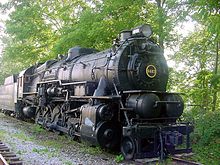2-10-0
These locomotives were popular in Europe, particularly in Germany and Russia; British use of the type was confined to the period during and after World War II.
In the United States, the 2-10-0 was not widely popular but was a favorite of a small number of railroads which operated mostly in mountainous terrain.
The 2-10-0's main advantage was that five out of six of its axles were powered, meaning almost all the weight was available for traction rather than being distributed over pilot and trailing wheels.
A firebox mounted over the drivers also restricted the diameter of the driving wheels, which in turn limited speed.
As with the Consolidation (2-8-0), "chopping" at speed ensured a rough ride for the crew due to instability caused by the wheel arrangement.
The type operated as freight engine, although locomotives in Germany and the United Kingdom proved capable of hauling passenger trains.
[1] No more followed for 19 years, until the Northern Pacific Railway bought two for use on the switchbacks over Stampede Pass, while the 2-mile (3.2 km) tunnel was being built.
Small numbers of other Decapods were built over the next twenty years, mostly for service in steeply graded mountainous areas where power at low speeds was the requirement.
The type was ideally suited to the Pennsy's heavily graded Allegheny Mountains routes, which required lugging ability according to tractive effort, not speed according to horse power.
Two giant cylinders (30½ x 32 inch) gave the I1s power and their tenders permitted hard and long workings between stops.
[8] A small number of other Decapods were ordered by other railroads; the I-2 Decapods built for the Western Maryland Railway were the largest ever built, at almost 420,000 lb (190 t) weight, and are a notable exception to the rule of thumb for the comfort of the ride on a 2-10-0 wheel arrangement, crews said the engines cruised smoothly up to 50 mph without becoming a rough ride.
In 1913 an initial design for a four-cylinder 2-10-0 of 53,328 pounds-force (237,000 N) tractive effort was produced by the Lancashire and Yorkshire Railway, but none were built.
This had been inspired by Jean-Baptiste Flamme's Type 36 (SNCB) [fr] 2-10-0s working in Belgium and used a similar tapered boiler, with the round-topped firebox almost filling the loading gauge.
[12] The class included 92220 Evening Star, the last steam locomotive built for British Railways, in 1960;[13] and 92203 (named Black Prince when preserved), which in 1983 set a record for the heaviest steam locomotive-hauled train in Britain when it started a 2,162-ton train at Foster Yeoman quarry in Somerset.
[14] The State Railroads of Finland purchased 20 American Decapods after WWII - these were originally built for the Soviet Union, but never delivered to them.
Moreover, at the end of World War II, SNCF inherited more than 200 units of German decapods built in France, mostly BR 44.
They used an automatic stoker to feed coal and had a relatively low axle load (18 tonnes or 40,000 lb) to be compatible with the war-torn railroads of the former Soviet Union.









